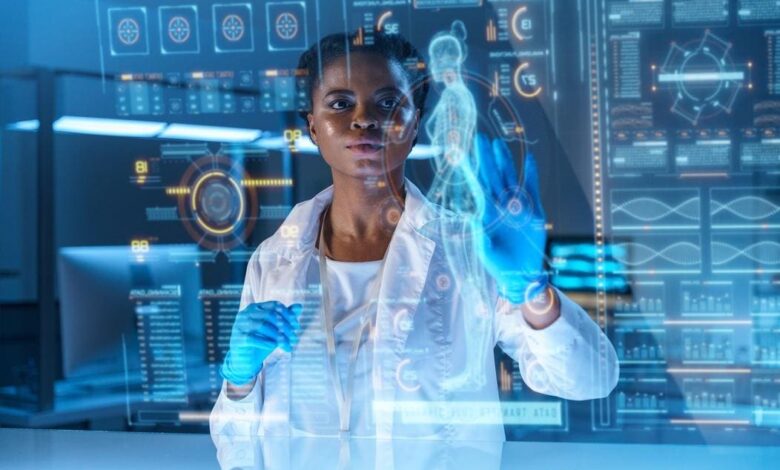How AI-Driven Diagnostics Can Save Lives When Humans Can’t

A young African – American doctor works on HUD or graphic display in front of her, we see her from … [+]
Today, chronic diseases – long-term conditions that require ongoing medical attention – are pushing the healthcare system to the brink of collapse. According to NIH, more than two-thirds of all deaths in America are caused by just five chronic diseases: heart problems, cancer, stroke, chronic obstructive pulmonary disease, and diabetes. On top of that, the dwindling count of healthcare workers isn’t helping either. Over 400,000 people have left the industry since the Covid pandemic began and many more are expected to quit in the future, leaving the rest of the workforce under immense pressure.
But AI can help, starting with the very first step of effective care: diagnosis.
How Can AI Take Care Of Diagnostics, And Improve Clinical Outcomes?
When the workforce is understaffed and the caseload is high, errors in diagnosis can easily occur. According to the estimates of the Society to Improve Diagnosis in Medicine, medical errors impact over 12 million Americans annually, leading to incorrect treatments and associated costs that likely exceed $100 billion. With AI in use, healthcare organizations can address this challenge, analyzing reports not only faster but also more accurately than humans could. In many cases, AI has even been able to diagnose medical conditions that humans could not. For instance, this very rare form of leukemia.
At the core of this effective diagnosis lies high-quality visual data and powerful machine learning and computer vision algorithms. When trained on high-quality data, the algorithms can identify intricate patterns within the patient samples, leading to better prediction of the condition and more insightful comparisons. They can process all sorts of medical imagery, right from MRIs and X-rays to ultrasounds, to detect subtle details that might elude human observation.
This can be very handy for the treatment of chronic conditions, which require accurate detection at first go for long-term care. Plus, since this is an AI system at work – and not a human, the process of analyzing the data and producing the diagnoses is relatively faster. Imagine someone getting to know about their tumor within a matter of days instead of weeks. They can get started with the treatment right away – which may lead to better clinical outcomes.
For healthcare providers, the speed and accuracy of AI can reduce the workload on staffers, enabling them to deliver a better quality of care. The AI model can work round the clock and deliver the same high-quality results for all samples, without taking a break or bias (if trained well). This may not be possible for humans who can suffer from fatigue and tiredness over time and make incorrect decisions based on their respective interpretations of the patient report.
Beyond this, AI algorithms can also improve healthcare accessibility in underserved populations and regions, where skilled staffers might be in short supply. The models could automate tasks and reduce clinical workloads, empowering non-specialists to undertake complex duties, like cardiac imaging and analysis. This can also bring healthcare to the homes of patients and smaller clinical settings.
Potential Across Domains
While many remain skeptical of AI’s potential in healthcare, the fact is visual data-driven AI diagnostics are already making an impact across different medical settings. For instance, it can help with the detection of abnormal findings on radiographs, particularly the improper positioning of catheters and tubes, which can lead to serious complications.
In busy clinical environments, there may be delays before a radiologist can thoroughly assess X-ray images. However, integrating computer vision as a second pair of eyes can help a lot. It enables the prompt detection of misplacements, allowing for immediate attention and prioritization. In recent times, AI models have been highly accurate in detecting and locating catheters on radiographs. This expedites the identification of critical issues, leading to timely interventions and improved patient outcomes.
Furthermore, AI is addressing the diagnostic challenges posed by brain tumors, where the variability of tumor shapes and sizes necessitates early detection. According to several reports, cutting-edge ML algorithms have demonstrated promise in speeding up tumor localization. Various models trained to segment tumors in MRI scans have also shown impressive accuracy levels.
Yes, there might be occasions when these tools may not be perfect. But even in those cases, they improve doctors’ decision-making processes, leading to more timely and precise interventions for the patients.
Notably, similar results have also been found in AI-driven diagnosis of skin cancer, which is not only the most widespread oncology disease in the US but also one that is very difficult to detect (even for experienced doctors) due to the inherent variability of skin lesions. A research paper from 2022, authored by Yinhao et al. and published in the Frontiers, demonstrated the success of AI in this domain by highlighting ML models outperformed the average capabilities of dermatologists and can help with the early detection of skin cancers.
Long Road Ahead
Despite immense potential across domains, the widespread adoption of AI and machine learning in medical diagnostics faces its fair share of roadblocks — across different areas.
For one, healthcare providers may exhibit hesitancy in implementing these transformative technologies until their performance is unequivocally proven in diverse clinical settings, and they are 100% satisfied they can trust the model for their work.
This can be addressed with the proactive support of policymakers who can facilitate the evaluation of machine learning diagnostic technologies across real-world scenarios, while simultaneously striving to expand access to medical data and foster collaboration among developers, providers, and regulators. Their work can lead to better models, expanded testing, and more confidence among the adopters of the technology.
The other roadblock in the adoption of AI diagnostics is the availability of high-quality training data. All teams today need good quality medical data to train their AI tools/models, but obtaining it means navigating a complex environment of ethical and regulatory restrictions. One has to take necessary approvals to access medical image files, anonymize data to adhere to various regulations, and ensure precise labelling by medical experts to establish a ground-truth dataset. This can be very labor-intensive and time-consuming.
As a solution, it is recommended to utilize data cleanrooms, such as one provided by Snowflake, or public datasets. However, it is important to note that even this may require some level of work to deal with issues like bias.
While it remains to be seen how the adoption of AI in diagnostics will grow in the coming years, one thing is confirmed: the marriage of AI and computer vision is here to revolutionize healthcare. Harnessing the power of data and AI holds the promise of transforming patient care, saving lives, and alleviating the financial burden on healthcare systems. To embrace it to the fullest and navigate the challenges that remain, all stakeholders – policymakers, healthcare providers, and technology developers – must come together.



